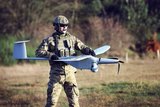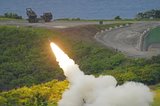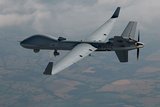JLENS deployed on US East Coast
The US Army has deployed a complete JLENS system on the East Coast of the US for the first time, Raytheon announced on 27 December. The system is designed to provide surveillance against advanced threats such as cruise missiles and aircraft.
JLENS, developed by Raytheon, consists of two helium-filled aerostats that float 10,000ft above the ground caring advanced radar systems.
The system is currently undergoing testing by Raytheon to ensure it is operating as designed, and will be handed over to the US Army’s A Battery, 3rd Air Defense Artillery following completion of testing and radar integration.
Dave Gulla, vice president, integrated defense systems' global integrated sensors, Raytheon, said: ‘JLENS is strategically emplaced to help defend Washington DC and a Texas-sized portion of the East Coast from cruise missiles, drones and hostile aircraft, JLENS can detect potential threats at extremely long ranges, giving North American Aerospace Defense Command more time to make decisions and more space to react appropriately.’
The second aerostat is scheduled to go aloft in early 2015. Following a series of additional tests, it will take part in an operational exercise. During the exercise, information from JLENS will be used by NORAD, the US-Canadian organisation charged with aerospace warning, aerospace control and maritime warning for North America. The 263rd Army Air and Missile Defense Command, which is responsible for defending the airspace over the National Capital Region, will also use information from JLENS.
Another JLENS system is in strategic reserve, ready to be deployed should a comprehensive cruise missile defence capability be required.
More from Digital Battlespace
-
![Babcock nears first customer for Nomad AI translation tool]()
Babcock nears first customer for Nomad AI translation tool
Nomad can provide militaries with real-time intelligence, saving critical time on the battlefield.
-
![AUSA 2025: Israel’s Asio Technologies to supply hundreds of improved Taurus tactical systems]()
AUSA 2025: Israel’s Asio Technologies to supply hundreds of improved Taurus tactical systems
Taurus operates alongside the Israel Defense Forces’ Orion system which supports mission management across tens of thousands of manoeuvring forces, from squad leaders to battalion commanders.
-
![AUSA 2025: Kopin pushes micro-LED plans as China moves faster]()
AUSA 2025: Kopin pushes micro-LED plans as China moves faster
The plan for the new displays follows fresh investment in Kopin’s European facilities by Theon and an order for head-up displays in fielded aircraft, with funding from the US Department of Defense.
-
![AUSA 2025: Persistent Systems to complete its largest order by year’s end]()
AUSA 2025: Persistent Systems to complete its largest order by year’s end
Persistent Systems received its largest ever single order for its MPU5 devices and other systems earlier this month and has already delivered the 50 units to the US Army’s 4th Infantry Division.
-
![Aselsan brings in dozens of companies and systems under the Steel Dome umbrella]()
Aselsan brings in dozens of companies and systems under the Steel Dome umbrella
Turkey has joined the family of countries attempting to establish a multilayered air defence system with government approval in August 2024 for the effort landed by Aselsan. Dubbed Steel Dome, the programme joins Israel’s Iron Dome, the US Golden Dome, India’s Mission Sudarshan Chakra and South Korea’s low-altitude missile defence system.
-
![DSEI 2025: MARSS unveils new agnostic multidomain C4 system]()
DSEI 2025: MARSS unveils new agnostic multidomain C4 system
MARSS’ NiDAR system has been deployed using sensors from static platforms to provide detection and protection for static sights, such as critical infrastructure, ports and military bases.




























